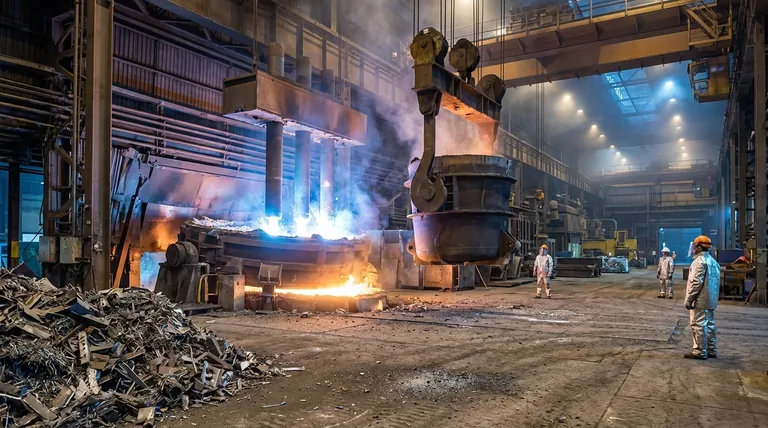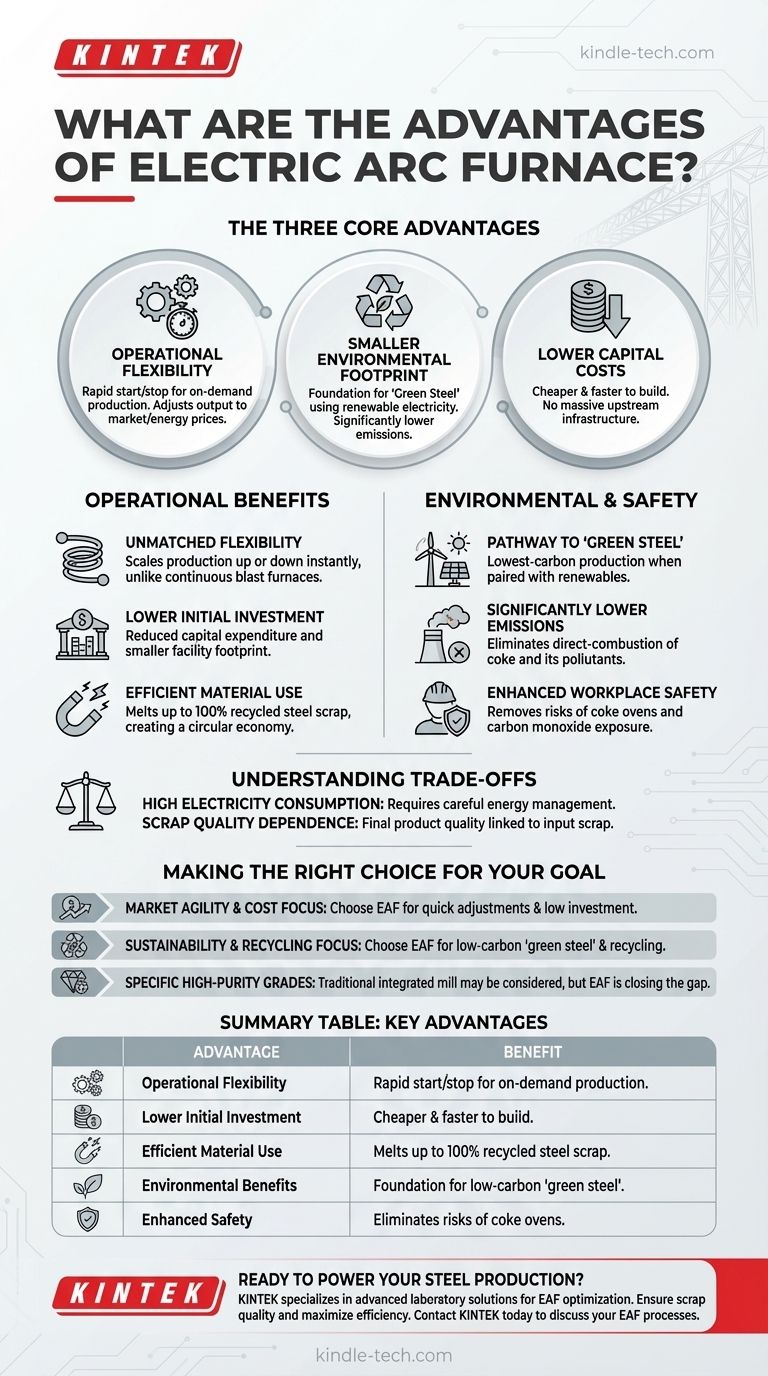At its core, the electric arc furnace (EAF) offers three primary advantages: exceptional operational flexibility, a smaller environmental footprint, and lower initial capital costs compared to traditional steelmaking. EAFs achieve this by using electricity to melt recycled steel scrap, allowing producers to adapt quickly to market demands without the massive infrastructure of a blast furnace.
The true strategic advantage of the electric arc furnace is its agility. It decouples steel production from the cumbersome, capital-intensive process of refining iron ore, enabling a more responsive, cost-effective, and sustainable manufacturing model.

The Core Operational Advantages
An EAF's design provides distinct benefits for a modern steel mill, focusing on speed, cost, and responsiveness. This contrasts sharply with the long, continuous cycles required by older technologies.
Unmatched Production Flexibility
Electric arc furnaces can be started and stopped rapidly. This allows a steel mill to scale production up or down in direct response to market demand or electricity pricing.
A traditional blast furnace, once started, must run continuously for years, making it impossible to adjust output quickly. The EAF's on-demand capability is a significant competitive edge.
Lower Initial Investment
Building a steel mill around an EAF is significantly cheaper and faster than constructing a traditional integrated mill.
EAFs do not require the massive upstream infrastructure of coke ovens and blast furnaces, drastically reducing the initial capital expenditure and physical footprint of the facility.
Efficient Use of Raw Materials
The primary feedstock for an EAF is scrap metal. These furnaces are incredibly effective at recycling, capable of using a charge of up to 100% recycled steel.
This ability turns a waste product into a valuable resource, creating a circular economy for steel and reducing reliance on virgin iron ore mining.
Environmental and Safety Benefits
By changing the fundamental energy source and raw materials, EAFs provide a pathway to more sustainable and safer steel production.
A Foundation for "Green Steel"
Because EAFs can be powered by renewable electricity sources, they are central to the industry's decarbonization efforts. Pairing an EAF with wind, solar, or hydropower creates one of the lowest-carbon steel production routes available today.
Significantly Lower Emissions
Traditional steelmaking burns massive amounts of coke (a coal derivative), releasing significant carbon dioxide and other pollutants like carbon monoxide.
EAFs eliminate this direct-combustion process. The primary emissions are linked to electricity generation, which can be cleaned at the source, resulting in a much cleaner overall process.
Enhanced Workplace Safety
By design, EAFs eliminate the inherent risks associated with blast furnaces and coke ovens. This includes removing the danger of exposure to harmful byproducts like carbon monoxide gas.
Understanding the Trade-offs
No technology is without its limitations. Objectivity requires acknowledging where EAFs face challenges.
High Electricity Consumption
EAFs are enormous consumers of electricity. A single furnace can demand enough power to run a small town, which can place a significant strain on local electrical grids.
Careful energy management is essential to maintain efficiency and control operating costs, especially in regions with high electricity prices.
Dependence on Scrap Quality
The quality of the steel produced in an EAF is directly linked to the quality of the input scrap.
Contaminants in the scrap metal (like copper, tin, or other elements) must be carefully managed to meet the specifications for the final product, which can add complexity to the supply chain.
Making the Right Choice for Your Goal
Selecting the right furnace technology depends entirely on your strategic objectives, from market conditions to environmental commitments.
- If your primary focus is market agility and lower capital cost: The EAF is the superior choice for its ability to quickly adjust production and its reduced upfront investment.
- If your primary focus is sustainability and recycling: The EAF is the cornerstone of modern steel recycling and the clearest path toward producing low-carbon "green steel."
- If your primary focus is producing very specific, high-purity steel grades from raw materials: A traditional integrated mill may still be considered, although EAF technology is rapidly closing the quality gap.
Ultimately, the electric arc furnace has reshaped the steel industry by providing a more flexible, cost-effective, and environmentally responsible production method.
Summary Table:
| Advantage | Key Benefit |
|---|---|
| Operational Flexibility | Rapid start/stop for on-demand production. |
| Lower Initial Investment | Cheaper and faster to build than blast furnaces. |
| Efficient Material Use | Melts up to 100% recycled steel scrap. |
| Environmental Benefits | Foundation for low-carbon 'green steel' production. |
| Enhanced Safety | Eliminates risks of coke ovens and blast furnaces. |
Ready to Power Your Steel Production with Agility and Sustainability?
Choosing the right furnace technology is critical to achieving your production and sustainability goals. KINTEK specializes in providing advanced laboratory equipment and consumables, including solutions for analyzing and optimizing electric arc furnace operations. Our expertise helps you ensure scrap quality, manage energy consumption, and maximize efficiency.
Let our team support your journey toward more flexible and environmentally responsible steelmaking. Contact KINTEK today to discuss how our lab solutions can enhance your EAF processes.
Visual Guide

Related Products
- Vertical Laboratory Quartz Tube Furnace Tubular Furnace
- 1700℃ Laboratory Quartz Tube Furnace with Alumina Tube Tubular Furnace
- 1400℃ Laboratory Quartz Tube Furnace with Alumina Tube Tubular Furnace
- Vacuum Induction Melting Spinning System Arc Melting Furnace
- Laboratory Muffle Oven Furnace Bottom Lifting Muffle Furnace
People Also Ask
- What is a vertical tube furnace? Leverage Gravity for Superior Uniformity and Process Control
- What is the temperature of a quartz tube furnace? Master the Limits for Safe, High-Temp Operation
- Why does heating increase temperature? Understanding the Molecular Dance of Energy Transfer
- How do you clean a tubular furnace tube? A Step-by-Step Guide to Safe and Effective Maintenance
- What is the standard thickness of plating? Optimize Durability, Corrosion & Cost



















